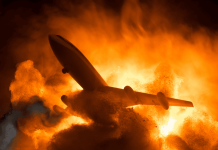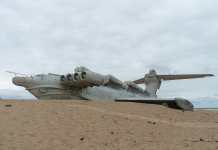Earlier this month, the S-300 air defense system attacked Israeli jets in northwestern Syria, marking the first instance of Russian-made S-300 missiles attacking Israeli warplanes.
World’s Largest Meeting? 100,000 Chinese Officials Meet To Discuss A ‘Serious Issue’ Plaguing Beijing
According to reports, at least one surface-to-air missile was launched at F-16 fighters while they were departing after striking Iranian targets near Syria’s northwestern city of Masyaf.
Exactly who operates the S-300 systems in Syria is unclear. However, reports suggest that Russian military personnel oversee operations of the Syrian S-300s, and Damascus needs Moscow’s authorization before it can fire them.
The incident marks a significant shift in Moscow’s policy, which had given tacit approval to IAF’s operations in Syrian airspace.

Rising Tensions Between Moscow And Tel Aviv
Tensions have escalated between Tel Aviv and Moscow due to differences over the war in Ukraine, particularly after reports emerged that Israel is considering sending military aid to Kiev.
Israeli officials reportedly attended the US-hosted summit about military aid for Ukraine at Ramstein Air Base in Germany last month.
The incident may also indicate that Russia could make things difficult for Israeli fighter jets to operate in Syria, thereby endangering its operations targeting Iranian arms transfers to militants in Syria and Lebanon.
According to the report by Israel’s Channel 12 News, the system’s radar did not lock onto any of the Israeli aircraft and, therefore, posed no danger to them.
While the Israeli jets escaped this time, it has suffered losses in the past during several attacks inside Syria. An F-16I Sufa fighter was brought down by a Syrian S-200 in early 2018, and reportedly there have been other aircraft that have suffered some damage.

The addition of the S-300 complicates Israel’s threat environment as it can cover large parts of Syrian airspace and target Israeli jets operating over Lebanon and even in northern Israeli airspace.
According to experts, while Israel can take on Syrian S-300s, however, the system could pose a formidable challenge. Israel has also acquired a fleet of stealthy fifth-generation F-35 Lightning II, which increases the odds it could successfully destroy the Syrian systems if it chose to.
Israeli F-35 Allegedly Shot By Russian-Origin Missile?
Interestingly, it was reported in late 2017 that one of IAF’s F-35 fighter jets was damaged by a Syrian S-200 missile.
In a series of statements that began on October 16, 2017, Israel announced that its aircraft had struck a Syrian SAM battery near Damascus that had fired two hours earlier on an unspecified Israeli plane flying over Lebanon.
However, later in the day, Israeli media reported that one of the IAF’s F-35I jets had been damaged in a bird strike nearly two weeks earlier. While the plane landed safely, the IAF was not sure whether it will remain operational.
Based on this, several media outlets published reports saying one of the IAF’s F-35s was hit by the Soviet-made S-200 missile in Syria.

The Syrian military statement also said that Israeli warplanes violated Syria’s airspace on the border with Lebanon in the Baalbek area, to which their “air defenses responded and directly hit one of the jets, forcing [the enemy] to retreat,” contradicting the Israeli claim that no warplane was hit.
Whereas the Israel Defense Forces (IDF) claimed that an anti-aircraft missile was indeed launched from Syria towards its aircraft, it was not a successful hit. Also, the IDF did not specify which aircraft was used for “routine flight” in Lebanon.
Moreover, it was not until 2018 that the Israeli F-35I became combat operational and therefore it would have been extremely unusual for the IAF to send its new F-35I fleet to fly along the Syrian border without achieving the initial operations capability (IOC).
The F-35I has been a delicate procurement subject for the Israeli government, as Israeli lawmakers at the time had publicly noted the high cost associated with the platform and stated that they would “meticulously assess” the need for more F-35 purchases beyond the first 50 ordered.

Therefore, risking the new jets before they were operational on a seemingly standard mission would not have made sense.
However, considering that Israel has a history of rushing fighters into service for unique operational needs, the possibility that an F-35I was operating over foreign territory cannot also be ruled out.
Israeli F-35 Can Be Used To Destroy S-300
That said, the American-made stealth fighter is arguably the most advanced fighter today and the Israeli version – the F-35I Adir, in particular, is unique and specialized for its requirements.
The IAF can externally modify the F-35I and has complete access to the fighter’s sophisticated digital architecture, including its electronic warfare and surveillance suite, communications systems, and mission control hardware.
The IAF can also install “plug-and-play” defensive countermeasures, including jamming pods in the fighter that can prevent the S-300 or other Russian-made air defense systems in Syria from locking on.
In addition to that, the F-35I features domestically-made weapon options, including the Rafael Spice EO/GPS guided bomb and an Israeli-designed cruise missile.
Therefore, as per Israeli claims, it appears that F-35s could possibly overcome the S-300 challenge. It is worth recalling that after a Syrian S-200 shot down an Israeli F-16 in 2018, Israel launched a series of retaliatory strikes between 2018-20 that destroyed at least one-third of Syria’s air defenses.
- Written by Tanmay Kadam/EurAsian Times Desk
- Contact the author at etdesk@eurasiantimes.com
- Follow EurAsian Times on Google News




